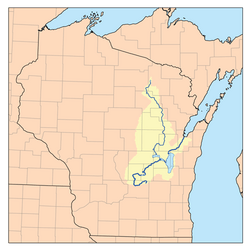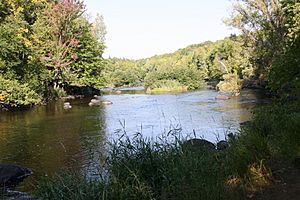Wolf River (Fox River tributary) facts for kids
Quick facts for kids Wolf River |
|
|---|---|

The Wolf River in downtown New London
|
|

Map of the Fox River watershed showing the Fox river (lower and right) and Wolf river (higher)
|
|
| Physical characteristics | |
| River mouth | Lake Butte des Morts Winneconne 748ft. |
| Length | 225mi. |
| Basin features | |
| River system | Fox-Wolf |
| Basin size | 3671sq.mi. |
| Type: | Scenic |
| Designated: | October 2, 1968 |

The Wolf River is a 225 mi (362 km) long river in northeastern Wisconsin, United States. It flows into the Fox River. This river is special because it's one of only two "National Scenic Rivers" in Wisconsin. About 24 miles (39 km) of the river are protected for their natural beauty.
The Wolf River and the Fox River are known for their amazing sturgeon fish. These fish swim upstream every spring to lay their eggs. The river flows mostly through wild forests. It starts in northern Forest County and goes south to Lake Poygan. This lake is connected to other lakes like Lake Winnebago. The Fox and Wolf Rivers together form a big river system.
The Menominee people, who are Native Americans, call the river Mahwāēw-Sēpēw. This means "wolf river" in their language.
Contents
Journey of the Wolf River
The Wolf River begins in a wild area called the Headwaters Wilderness. This area is part of the Chequamegon–Nicolet National Forest. The river's northernmost start is where Wildcat Creek and Pine Creek meet at Pine Lake.
The river flows south through several counties. It passes through Langlade and Menominee counties. These parts of the river are famous for exciting whitewater rafting! Most of Menominee County is part of the Menominee Indian Reservation.
Next, the Wolf River flows through Shawano County. Here, another river called the Red River joins it. The Wolf River then goes past the city of Shawano. It continues through Waupaca and Outagamie counties.
Finally, the Wolf River collects water from the Embarrass River near New London. It also meets the Little Wolf and Waupaca rivers. The river then flows through Winnebago County and Lake Poygan. It passes through Winneconne before emptying into Lake Butte des Morts. This lake is part of the Fox River.
River Connections
Many smaller rivers and creeks flow into the Wolf River. Some of these are Wildcat Creek, Pine Creek, Pine River, Rat River, Waupaca River, Little Wolf River, Embarrass River, Shioc River, Red River, Evergreen River, Lily River, and Hunting River.
The Wolf River's water eventually reaches the Fox River at Lake Butte des Morts. From there, it flows into Lake Winnebago. Then, it goes into Green Bay, which is part of Lake Michigan. The water from Lake Michigan travels through the Great Lakes and the St. Lawrence River. Finally, it reaches the Atlantic Ocean!
Protecting the Wolf River
People who care about nature have worked hard to protect the Wolf River. For example, a mining project was once planned near a river that flows into the Wolf River. But local tribes and environmental groups worked together to stop it. They bought the land in 2003 to keep the river safe and clean. This shows how important it is to protect our natural places.
Helping Sturgeon Fish Reproduce
Two dams on the upper Wolf River, built a long time ago, stop sturgeon from reaching their old spawning grounds. Spawning grounds are places where fish lay their eggs. For over 100 years, sturgeon couldn't lay eggs above these dams.
Since 2012, the Wisconsin Department of Natural Resources (WDNR) and the Menominee tribe have been working together. They catch adult sturgeon below the dams and move them above the dams. This helps the sturgeon lay their eggs in new areas. They also use sturgeon eggs and young fish to create a new sturgeon population in Legend Lake. The sturgeon successfully laid eggs at the falls the very next year!
The tribe has suggested building "fishways" around the dams. These would be like special paths for fish to swim around the dams. This would let sturgeon from Lake Winnebago reach their spawning grounds naturally. However, there are worries about spreading fish diseases, so the capture and relocation program is still ongoing.
Zebra Mussels: An Unwanted Guest
Zebra mussels are tiny shellfish that are not native to Wisconsin. They come from areas near Russia and Ukraine. These mussels can cause problems by clogging pipes and sticking to boats. They can also make beaches sharp to walk on.
Zebra mussels were found in the Winnebago Pool, which includes the Wolf River, as early as 1999. Scientists are working to understand and manage these mussels to protect the river's ecosystem.
Animals in the Wolf River
Fishing Fun
The Wolf River is a great place for fishing! Many different kinds of fish live here. In 2016, a record-breaking Quillback fish was caught in the Wolf River. It was 25.0 inches (64 cm) long and weighed almost 9 pounds 15.8 ounces (4.53 kg)!
Sturgeon Fish Life Cycle
The Winnebago river system, including the Wolf and Fox Rivers, has the largest population of Lake sturgeon in the world. These amazing fish have been around since the time of dinosaurs!
Sturgeon swim upstream from Lake Winnebago to the Wolf River every spring, usually between April 15 and May 5. Female sturgeon lay their eggs only every four to six years, starting when they are about 20 years old. They can live up to 50 years and grow to be five feet long! They lay their eggs in the shallow parts of the Wolf River.
To protect these special fish during spawning season, a group of volunteers called "Sturgeon For Tomorrow" watches over the spawning sites. This helps keep the sturgeon safe when they are most vulnerable.
Walleye Fish
The walleye is another very popular fish in the Wolf River, especially in the spring during their spawning period. Many fishermen come to catch their daily limit of walleye. It's one of the most prized fish in the river!
White Bass Fish
The white bass is a freshwater fish that also spawns in the Wolf River. Their spawning season usually happens in the last two weeks of May. During this time, many fishermen come to the Wolf River system. White bass caught here are typically 8 to 12 inches long. A common fishing method used is called the "river rig" or "Wolf River rig."
Places to See
There are two towns named after the river: Wolf River, Winnebago County and Wolf River, Langlade County. Both are located along the river's path.

